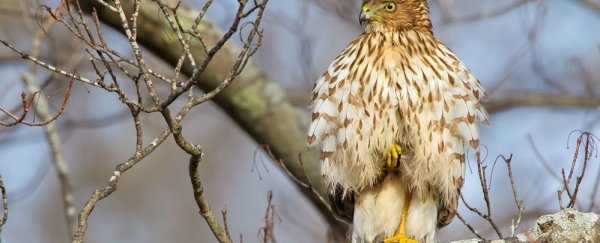A Cooper's hawk discovered near a waste transfer station in greater Vancouver, Canada, is believed to be the most polluted wild bird ever discovered. In fact, it was so contaminated with flame retardant chemicals that it was "flameproof", according to a press release.
The researchers from McGill University in Quebec came across the hawk when analysing liver samples taken from birds of prey that had been fatally injured near Vancouver in the province of British Columbia (BC). The bird contained an unheard-of 196 parts per million of polybrominated diphenyl ethers (PBDEs) - now-banned chemicals that were once widely used as flame retardants in furniture, vehicles and electronics.
This is 105 times higher than other birds of prey in Vancouver, and also significantly more contaminated than birds found in California or an electronic waste site in China.
"We were surprised to see such high levels of contaminants in what I think of as 'green' city," said lead author Kyle Elliott in the release. "We can only hope that because many forms of PBDEs have now been banned and the levels of these contaminants are rapidly disappearing from herons and cormorants in Vancouver, the same will be true for other bird species."
Even though many PBDEs have been banned since the early 2000s in Canada because of their damaging effects on the environment and the human nervous system, the chemicals continue to accumulate in landfill sites, as old PBDEs-contaminated items break down. In the British Columbia Fraser River delta, it's estimated that PBDEs have doubled every four years over the past 40 years. This contamination can be passed on to wild animals living nearby.
Publishing in the journal Science of the Total Environment, the researchers investigated by comparing the toxicity levels of PBDEs in the liver fat of 13 birds of prey across Vancouver. On average, the level of PBDEs was around 1,873 parts per billion - but one individual found in Langley, BC, had concentrations 105 times this amount.
It's believed that this particular Cooper's hawk may have ended up so polluted after eating starlings that lived near the Langley landfill site. "The levels of flame retardants in starlings, a favourite prey of hawks, which nested near the landfill site were fifteen times higher than levels in starlings found elsewhere in Vancouver," said Elliott.
The hawk doesn't appear to have died from the chemicals, but it's likely they would have had toxicological effects, including depressing the production of the bird's thyroid hormones, "impacting metabolism, growth rate, and behaviour," as Elliott told The Vancouver Sun.
